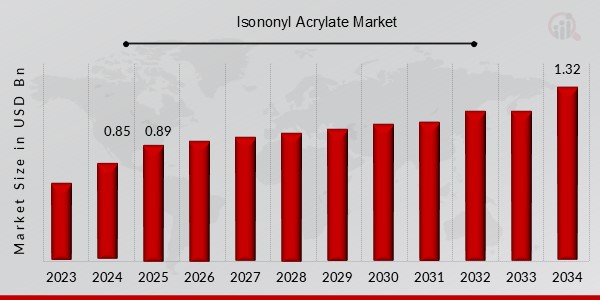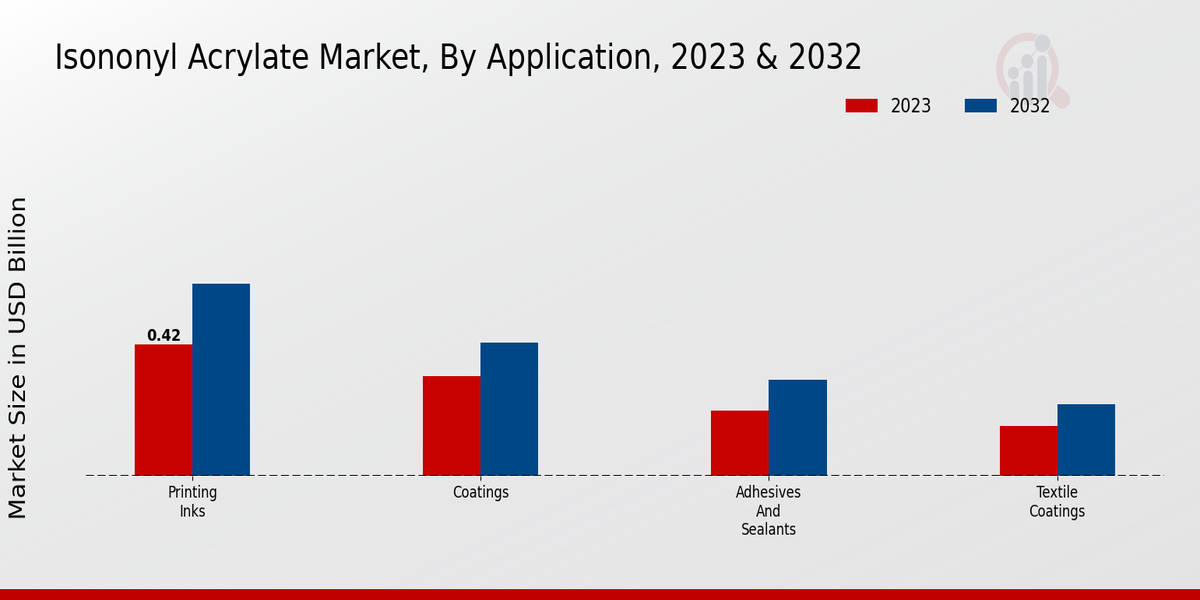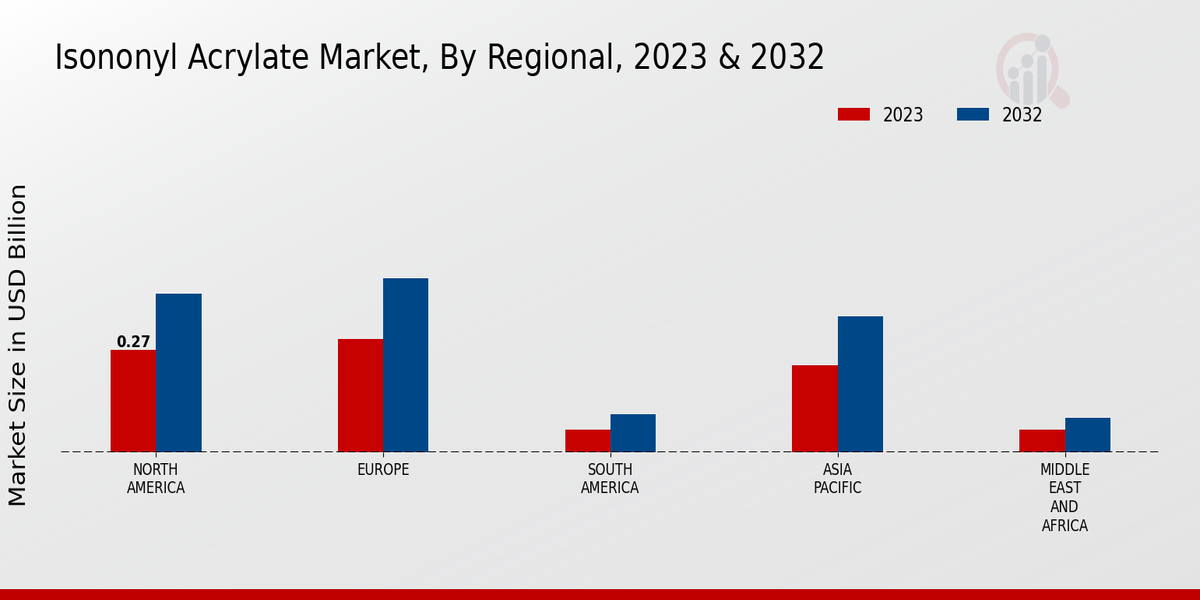Global Isononyl Acrylate Market Overview
Isononyl Acrylate Market size was estimated at 0.85 (USD Billion) in 2024. The isononyl acrylate market is expected to grow from 0.89 (USD Billion) in 2023 to 1.32 (USD Billion) by 2034. The isononyl acrylate market CAGR (growth rate) is expected to be around 4.43% during the forecast period (2025 - 2034).

Source Primary Research, Secondary Research, MRFR Database and Analyst Review
Key Isononyl Acrylate Market Trends Highlighted
Rising demand for water-borne and UV-curable coatings in various end-use industries is driving the growth of the isononyl acrylate market. The increasing use of isononyl acrylate in the production of high-performance adhesives, sealants, and printing inks is further boosting the market growth.
Moreover, the growing emphasis on eco-friendly products and regulations favoring the use of low-VOC materials is creating opportunities for isononyl acrylate manufacturers. Recent trends also indicate a shift towards bio-based isononyl acrylate, driven by the increasing environmental consciousness among consumers and manufacturers alike.
Isononyl Acrylate Market Drivers
Growing Demand for UV UV-curable coatings
One of the major drivers of the isononyl acrylate market is the increasing demand for UV-curable coatings across the automotive, electronics, and packaging industries. UV curable coatings offer many advantages, such as fast curing time, low energy consumption, and high durability, which make them the preferable choice for a broad range of applications.
The growth of the UV curable coatings market is likely to drive the isononyl acrylate market because the latter is a key raw material amassing in the production of such coatings.
The automotive industry is one of the major consumers of UV curable coatings, as they used in the production of all kinds of automotive parts and components, such as bumpers, spoilers, and interior car trim. The increase in the production of cars across the world, especially in the emerging markets, is likely to boost the demand for UV curable coatings and, thus, isononyl acrylate.
The electronics industry also benefits greatly from UV-curable coatings as they are widely used in the production of printed circuit boards, screens, and other electronic parts and displays.
The demand for electronics, such as smartphones, laptops, and tablets, is likely to rise across the world, which will be reflected in the rise of isononyl acrylate demand.
The packaging industry is also one of the largest consumers of UV curable coatings, as they are used in the production of all sorts of flexible packaging, labels, and other packaging materials. The demand for packaged goods is expected to rise across the world because of the increasing popularity of retail trade in the food and beverages industry.
Rising Demand for Waterborne Coatings
The isononyl acrylate market is driven by the rapidly increasing demand for waterborne coatings. Waterborne coatings are the paints or coatings which are based on water as a solvent. They are more environment friendly than the solvent based coatings, as there is considerably higher percentage of water in the coatings, thus, reduced VOCs emission.
The stringent regulations of the U.S. Environmental Protection Agency to reduce VOC emissions will boost the waterborne coating demand, in turn escalating the isononyl acrylate market.
The waterborne coatings are largely consumed in architectural paints and coatings in the construction industry. The increasing demand for the waterborne coatings owing to the increasing demand for green building materials, lower energy costs, reduced construction waste, and enhanced durability is estimated to boost the demand in turn escalating the isononyl acrylate market.
The other notable application segment is the automotive industry, as they are consumed in the production of automotive parts and components such as bumpers, spoilers, and interior trim.
Several automotive companies are developing eco-friendly vehicles due to the high demand, and regulatory demand is expected to boost the application segment and escalate the isononyl acrylate market.
Waterborne coatings are also consumed in the packaging industry for manufacturing flexible packaging, labels, and other packaging materials, for which the demand is increasing due to sustainable packing solutions.
Technological Advancements in UV Curing Technology
Technological advancements in UV curing technology are also driving the growth of the isononyl acrylate market. UV curing technology involves the use of ultraviolet light to cure coatings and adhesives, offering advantages such as fast curing times, high energy efficiency, and improved product quality.
The development of new and improved UV curing systems is expected to further drive the demand for isononyl acrylate, which is a key raw material used in the production of UV-curable coatings and adhesives.
Isononyl Acrylate Market Segment Insights
Isononyl Acrylate Market Application Insights
The isononyl acrylate market is divided by application. The application segments include printing inks, coatings, adhesives and sealants, and textile coatings. Printing Inks. Isononyl acrylate is used to manufacture printing inks.
In particular, it is used in the printing of flexible packaging and commercial applications. The material’s advantageous properties include vine adhesion to various surfaces, excellent printability, and high-speed printing. The growth of the isononyl acrylate market in the printing inks segment will be propelled by the growing demand for packaging, labels, and other printed products.
Moreover, these products best meet general requirements related to the application of color on printed materials. Coating. Isononyl acrylate is widely used in the formulation of coatings. The group of possible materials to coat includes wood, metal, and plastic.
The specific properties that will be achieved by the material include scratch and chemical resistance and weatherability. The growth of the isononyl acrylate market in the coatings segment will be driven by the growing demand for coating in the automotive, construction, and electronics industries.
Particular attention will be paid to packing the products that affect the environment. Adhesive and sealant. Isononyl acrylate will serve as the main component used to develop strong adhesives and sealants with characteristics to attach firmly to any surface, withstanding intense natural and man-induced environmental effects.
The rationale behind the growth of the isononyl acrylate market in this segment is the growing demand for adhesives and sealants in the packing, construction, and transportation segments. Adhesive bond systems will be chosen based on the requirements of the final product.
Isononyl acrylate is used to create textile coatings. The specific properties to be gained include water, oil, and grease repellency, moisture, flame, stain, and wrinkle resistance of the coating to dirt and dust. The beneficial properties keep the fabric look clean.
The growth of the isononyl acrylate market in the textile coatings segment is due to the growing demand for functional and durable textiles in the apparel, home, and transportation industries. As a result, the isononyl acrylate market will grow significantly across all application segments because the demand is growing in all markets.
The printing ink segment coating, adhesive and sealants, and textile coatings will trigger the most significant growth.

Source Primary Research, Secondary Research, MRFR Database and Analyst Review
Isononyl Acrylate Market End-user Insights
The End User segment of the isononyl acrylate market exhibits a diverse landscape, each sector presenting unique dynamics and growth prospects.
Isononyl Acrylate finds significant application in packaging, particularly in the production of food contact materials and flexible packaging films. Its resistance to oil, grease, and solvents makes it an ideal choice for packaging food products, beverages, and personal care items.
The rising demand for convenience food and beverages is expected to drive growth in this segment. Construction In the construction industry, Isononyl Acrylate is employed as a component in adhesives, sealants, and coatings.
Its excellent adhesion properties and durability make it suitable for applications such as flooring, roofing, and exterior cladding. The growing construction sector, particularly in emerging economies, is anticipated to boost demand in this segment.
Isononyl Acrylate is used in the automotive industry to manufacture interior and exterior components such as dashboards, seat covers, and bumpers. Its resistance to UV radiation, wear, and chemicals ensures the longevity of these components.
The increasing production of automobiles globally is projected to contribute to the growth of this segment.
Isononyl Acrylate finds application in a wide range of consumer products, including paints, coatings, and adhesives. Its versatility and performance characteristics make it suitable for various household and industrial applications. The growing consumer demand for durable and aesthetically pleasing products is anticipated to drive growth in this segment.
Isononyl Acrylate Market Grade Insights
The isononyl acrylate market is segmented by grade into standard, high, and premium grades. In 2023, the standard grade segment accounted for the largest share of the market, with a revenue of USD 0.34 billion.
The high-grade segment is expected to grow at a CAGR of 4.8% over the forecast period, reaching a revenue of USD 0.46 billion by 2032. The premium-grade segment is expected to grow at a CAGR of 5.2% over the forecast period, reaching revenue of USD 0.36 billion by 2032.
The growth of the high and premium-grade segments is attributed to the increasing demand for high-performance coatings and adhesives.
High grade isononyl acrylate is used in the production of coatings that are resistant to abrasion, chemicals, and corrosion.
Premium grade isononyl acrylate is used in the production of adhesives that are high strength and durable. The demand for these grades is expected to grow as the construction and automotive industries continue to expand.
Isononyl Acrylate Market Sales Channel Insights
The isononyl acrylate market is segmented into various sales channels such as direct sales, distribution channels, and online platforms. Direct sales involve manufacturers selling Isononyl Acrylate directly to end-users, providing higher margins but limited reach.
Distribution channels involve intermediaries such as distributors and wholesalers who connect manufacturers with end-users, resulting in wider distribution but lower margins. Online platforms have gained prominence, enabling manufacturers to reach a wider customer base and facilitate e-commerce transactions.
In 2023, direct sales held the largest share of the isononyl acrylate market, accounting for approximately 45% of the total revenue.
Distribution channels are expected to witness steady growth, driven by the expansion of regional distribution networks and the increasing adoption of outsourcing by manufacturers. Online platforms are projected to grow at a significant CAGR, owing to the rising popularity of e-commerce and the convenience of online purchasing.
Isononyl Acrylate Market Regional Insights
The regional segmentation of the isononyl acrylate market offers insights into the market's distribution across different geographic regions. North America held the dominant position in the market in 2023, accounting for approximately 35% of the revenue, driven by strong demand from the automotive and construction industries.
Europe followed closely behind, contributing around 30% to the market revenue, with key markets such as Germany and France leading the demand.
The APAC region is projected to exhibit the highest growth rate during the forecast period, owing to the rapidly growing construction and packaging industries in countries like China and India.
South America and MEA are expected to contribute a relatively smaller share of the market but are anticipated to experience steady growth in the coming years.

Source Primary Research, Secondary Research, MRFR Database and Analyst Review
Isononyl Acrylate Market Key Players and Competitive Insights
The following companies and their strategies define the isononyl acrylate market Development and will define it in the future. They occupy the basic market share and have the greatest influence on the existing and prospective state of affairs in this sector.
To begin with, it is necessary to stress that the most important and influential companies are focused on the enhancement of their productive capacity. At the same time, it is important to note that the isononyl acrylate market will develop rapidly and such a position is predetermined by the growing demand in two main sectors, namely construction and automobile manufacturing.
Moreover, the companies that are key players in the market pay considerable attention to research work and implement innovative technologies, leading to the introduction of new products and materials. Yet it should be said that the isononyl acrylate market is quite competitive and several companies play an important role in the market.
Among these companies are Evonik Industries, BASF SE, The Dow Chemical Company, and Arkema. They invest prominently in research work and developing new products and materials. At the same time, they enhance their productive capacity to maintain the existing market share and meet the growing demand for isononyl acrylate.
First of all, it should be said that Evonik Industries is one of the key players in the isononyl acrylate market. To a significant extent, such a position is determined by the high level of efficiency of the innovation work in this company. Evonik Industries produces a variety of products including isononyl acrylate.
This is one of the leading isononyl acrylates market companies that have a strong position. The company has its sales offices and productive facilities in Europe, Asia and the Americas. In such a way, the efficiency of the company provides it with a stable market share, but it should be said that presently Evonik Industries is enhancing its productive capacity consistently to meet the growing demand.
Key Companies in the isononyl acrylate market Include
- ExxonMobil Chemical Company
- Dow Chemical Company
- DIC Corporation
- PTT Chemical Public Company Limited
- Covestro AG
- Mitsubishi Gas Chemical Company, Inc.
- LyondellBasell Industries Holdings B.V.
- LG Chem, Ltd.
- Huntsman Corporation
- Eastman Chemical Company
- SABIC
- Evonik Industries AG
- Lotte Chemical Corporation
- Wanhua Chemical Group Co., Ltd.
- BASF SE
Isononyl Acrylate Market Developments
The market growth is primarily driven by the increasing demand for isononyl acrylate in the production of acrylic polymers, which are used in various end-use industries such as automotive, construction, and packaging.
The automotive industry is a major consumer of isononyl acrylate, as it is used in the production of interior and exterior components such as dashboards, door panels, and bumpers.
The growing demand for lightweight and fuel-efficient vehicles is driving the growth of the automotive industry, which in turn is expected to boost the demand for isononyl acrylate.
Furthermore, the increasing construction activities in emerging economies are expected to contribute to the growth of the isononyl acrylate market. Isononyl acrylate is used in the production of floor coverings, wall paints, and adhesives, which are essential components in the construction industry.
The growing awareness of environmental sustainability is also driving the demand for isononyl acrylate, as it is a biodegradable and environmentally friendly alternative to traditional acrylic monomers.
Isononyl Acrylate Market Segmentation Insights
-
Isononyl Acrylate Market Application Outlook
-
Printing Inks
-
Coatings
-
Adhesives and Sealants
-
Textile Coatings
-
Isononyl Acrylate Market End User Outlook
-
Packaging
-
Construction
-
Automotive
-
Consumer Products
-
Isononyl Acrylate Market Grade Outlook
-
Standard Grade
-
High Grade
-
Premium Grade
-
Isononyl Acrylate Market Sales Channel Outlook
-
Direct Sales
-
Distribution Channels
-
Online Platforms
-
Isononyl Acrylate Market Regional Outlook
-
North America
-
Europe
-
South America
-
Asia Pacific
-
Middle East and Africa
| Report Attribute/Metric |
Details |
| Market Size 2024 |
0.85 (USD Billion) |
| Market Size 2025 |
0.89 (USD Billion) |
| Market Size 2034 |
1.32(USD Billion) |
| Compound Annual Growth Rate (CAGR) |
4.43% (2025 - 2034) |
| Report Coverage |
Revenue Forecast, Competitive Landscape, Growth Factors, and Trends |
| Base Year |
2024 |
| Market Forecast Period |
2025 - 2034 |
| Historical Data |
2020 - 2024 |
| Market Forecast Units |
USD Billion |
| Key Companies Profiled |
ExxonMobil Chemical Company, Dow Chemical Company, DIC Corporation, PTT Chemical Public Company Limited, Covestro AG, Mitsubishi Gas Chemical Company, Inc., LyondellBasell Industries Holdings B.V., LG Chem, Ltd., Huntsman Corporation, Eastman Chemical Company, SABIC, Evonik Industries AG, Lotte Chemical Corporation, Wanhua Chemical Group Co., Ltd., BASF SE |
| Segments Covered |
Application, End User, Grade, Sales Channel, Regional |
| Key Market Opportunities |
Rising demand for waterborne coatings, growth of the construction industry, increasing use of adhesives and sealants, the expanding automotive sector, and increasing environmental awareness. |
| Key Market Dynamics |
Increased demand for waterborne coatings The growing automotive industry The rising construction sector Expansion of packaging applications Technological advancements |
| Countries Covered |
North America, Europe, APAC, South America, MEA |
Frequently Asked Questions (FAQ) :
The isononyl acrylate market is projected to grow at a CAGR of 4.43% from 2025 to 2034.
The isononyl acrylate market is expected to reach a valuation of 1.32 billion USD by 2034.
The Asia Pacific region is projected to dominate the isononyl acrylate market throughout the forecast period.
Isononyl Acrylate finds extensive applications in the production of paints, coatings, adhesives, and sealants.
Key players in the isononyl acrylate market include BASF, Evonik, Dow, and Arkema.
Rising demand for Isononyl Acrylate in the construction and automotive industries is a major factor driving market growth.
The isononyl acrylate market was valued at around 0.89 billion USD in 2025.
The construction industry accounts for a significant share of Isononyl Acrylate consumption.
Growing demand for high-performance coatings and increasing urbanization present key growth opportunities in the isononyl acrylate market.
Fluctuating raw material prices and stringent environmental regulations pose challenges to the isononyl acrylate market.
















